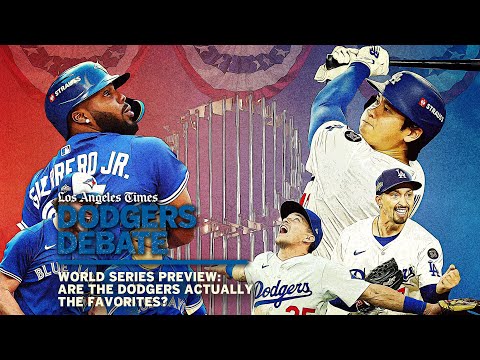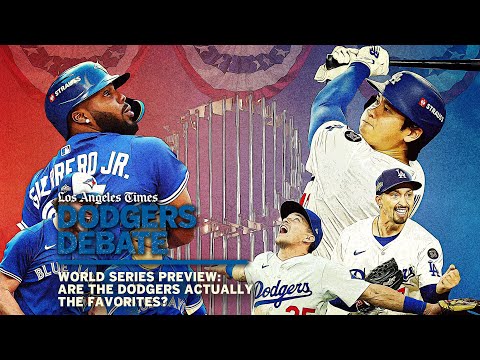How difficult season transformed Blake Snell into Dodgers’ October ace
For much of the year, the Dodgers’ starting rotation felt broken.
In large part, because the pitcher acquired to be its anchor was struggling to find himself.
It’s easy to forget now, with Blake Snell in the midst of a historic October performance that has helped lead the Dodgers back to the World Series. But for most of his debut season in Los Angeles, the two-time Cy Young Award winner and $182 million offseason signing was grappling with frustration, enduring what he described recently as “the hardest year of my career.”
First, there was well-documented early adversity: A shoulder problem that Snell quietly pitched through in two underwhelming starts at the beginning of the campaign, before sidelining him on the injured list for the next four months.
Then, there was an ordeal Snell detailed last week for the first time: In late August, on the same day his wife Haeley gave birth to the couple’s second child, Snell got so sick in the hospital that he fainted, was taken to the emergency room, and kept overnight hooked up to IV fluids.
“This is awful,” he thought to himself then.
Which now, has made his dominant postseason — including an 0.86 ERA in his first three playoff outings, and a scheduled Game 1 start in the World Series on Friday night — all the more gratifying.
“It’s been a lot,” Snell told The Times last week, while reflecting on a difficult season now primed for a triumphant final act. “But that’s what this is all about. Find the best in yourself. Fight through all the doubt, the bull—. And figure it out.”
In many ways, figuring things out has been the story of the Dodgers’ entire season. From their inconsistent and injury-riddled offense. To their underperforming and injury-ravaged bullpen. To their ever-evolving rotation, most of all.
Early in the year, that group dealt with its own rash of injuries, losing Snell, Tyler Glasnow, Roki Sasaki and others in a harrowing flashback to 2024.
This time, most of their top arms returned healthy. But up until six weeks ago, they still faced genuine questions for the fall.
At that point, Yoshinobu Yamamoto was mired in an up-and-down stretch following his All-Star selection in the first half of the year, raising worries he could be tiring en route to making a career-high 30 starts.
Glasnow had returned from his early-season shoulder problem, but grinded through six starts from July 29 to Aug. 30 with an ERA above 4.00.

And while Shohei Ohtani was pitching well, he was also continuing to build up in his return from a second career Tommy John surgery.
Suddenly, it all left Snell to be the linchpin for the pitching staff — thrusting him to the center of the late-season resurgence that was soon to come.
“With every great starting staff, you got to have that anchor,” manager Dave Roberts said. “Having him get back to pitch the way he did, sort of raised the bar for everyone.”
This past winter, the Dodgers made Snell their top priority for a reason.
They looked at the patchwork rotation that nearly derailed their 2024 World Series run, and decided the year’s staff needed another star to build around.
Yamamoto, Glasnow and Ohtani already provided a well-established foundation. Clayton Kershaw, Emmet Sheehan, Tony Gonsolin and Dustin May offered plenty of depth to withstand a 162-game marathon.
What was missing, however, was another bona fide ace; the kind capable of swinging postseason series and transforming October fortunes. In Snell, they saw such potential. His presence, they hoped, would complete their title-defense blueprint.
“As we were talking about ways that we could put ourselves in the best position to win a World Series in 2025,” president of baseball operations Andrew Friedman said the day Snell was introduced by the club, “all conversations kept coming back to Blake.”
For most of the year, of course, Snell’s impact was limited. After his two injury-hampered starts at the beginning of the season, he remained out of action until after the trade deadline.
During that time, the Dodgers slow-played Snell’s recovery — putting him through a meticulous process (similar to their handling of Glasnow and Ohtani) that was designed to have him ready for the stretch run of the season, and hopefully peaking in time for the start of the playoffs.
Upon his initial return in early August, Snell seemed to be on track, with the left-hander posting a sub-2.00 ERA in his first four outings off the IL.
Then, however, came another unforeseen setback, after he rushed home from an Aug. 22 outing in San Diego for the birth of his child.
By the time Snell’s wife went into labor later that week, the 32-year-old arrived at the hospital feeling “extremely sick,” he recounted last week. At one point, as he got up from a couch to go hold his newly born baby, he said he passed out and fainted right there in the room.
Snell was taken to the emergency room and stayed there overnight, getting two IVs to combat an unspecified illness undoubtedly compounded by exhaustion.
“I couldn’t really stand,” he said. “I just felt awful.”
And yet, a few days later, there Snell was back atop the Dodger Stadium mound; making sure that, after his extended absence earlier in the campaign, he wouldn’t miss another start.
“That’s what I signed up to do,” Snell said. “When I pitch, I just forget about it. I don’t allow a lot of excuses.”
Snell’s illness was unknown at the time, but the physical toll it had taken quickly became obvious. His velocity was noticeably down in a three-run, 5 ⅓ innings start on Aug. 29 against the Arizona Diamondbacks. Six days later, he toiled again during a “frustrating” outing in Pittsburgh, yielding a season-high nine hits and five runs to the lowly Pirates.
Pushing through those games, though, gave Snell a key to hone in on for the rest of the season. “If this is who you are today, figure it out,” he told himself. And finally, with no more disruptions to his routine, improvement flowed quickly.
Dodgers pitcher Blake Snell puts his arm around catcher Ben Rortvedt as they walk back to the dugout together on Sept. 17.
(Gina Ferazzi/Los Angeles Times)
Snell struck out a season-high 11 batters over six scoreless innings in a Sept. 10 win against the Colorado Rockies. He topped that a week later with 12 punchouts in seven scoreless frames against the Philadelphia Phillies.
Snell said after that outing, which was followed by one more six-inning, one-run start in his regular-season finale in Arizona: “[I’m] starting to be able to play catch with more intent and work on stuff … Coming through in the push to the postseason, and being able to make it, that’s what the whole season is for.”
The old adage in baseball is that hitting can be contagious.
In the case of this year’s Dodgers, starting pitching evidently can be, too.
As Snell got hot in September, so did the rest of the team’s resurgent rotation. Yamamoto rediscovered his early-season form, winning National League pitcher of the month with an immaculate 0.67 ERA in four starts. Glasnow finished the month with a 2.49 mark, after finally refining the mechanics of his throw. Ohtani, meanwhile, got stretched out to six innings, maintaining his two-way dominance over repeated full-length appearances.
The bar had been raised, with the constant cycle of gems continuing to push it a little bit higher.
The pitchers rode off the momentum and relished in their shared success; to the point that Roberts joked they almost seemed to be competing to outdo one another.
“I think we’re all good,” Glasnow said. “So it was just a matter of time until all of us did good at the same time.”
But in these playoffs, no one has been more lethal than Snell. In his 21 innings so far, he has thrown a scoreless frame in all but one.
Dodgers pitcher Blake Snell walks off the mound after striking out the last batter of the second inning of Game 2 of the NLDS against the Philadelphia Phillies.
(Robert Gauthier / Los Angeles Times)
He was good in his first start, producing seven innings of two-run ball against the Cincinnati Reds in the wild-card round. He was superb in the next, going six scoreless against the Phillies in a hostile road environment.
His masterpiece, however, came in Game 1 of the NL Championship Series, when he tossed eight scoreless innings, struck out 10 batters, and ruthlessly toyed with a Milwaukee Brewers lineup helpless to adjust to his manipulative changeup.
“We’ve all known this: Blake, when he’s right, is the best pitcher in the game,” Kershaw, his future Hall of Fame teammate, said afterward. “To have a guy that can do that, set the tone, and just have a guy that you can count on like that, it’s huge.”
For his part, Snell continues to insist that “I feel like I could be way better.” After his repeated setbacks earlier this year, he claims that, “even now, I’m still battling.”
The numbers, of course, tell a different story. In the live-ball era (since 1920), only three other pitchers with 20 or more innings in a postseason had at least 20 strikeouts and a sub-1.00 ERA (Sandy Koufax in 1965, John Smoltz in 1996 and Justin Verlander in 2013).
On Friday night, Snell will be on the bump once again, trying to continue a dazzling streak for himself and his rotation.
What once felt like the hardest year of his career, is now four wins away from being the most fulfilling.
“It’s what you have to go through to win a World Series,” he said. “You can find an excuse, or you can find a way to figure it out.”



